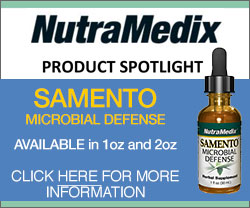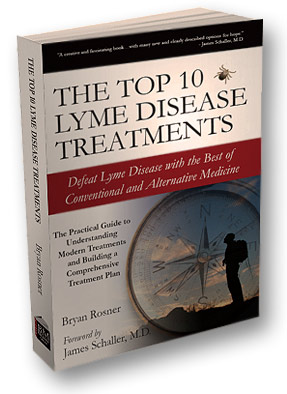|
n the previous section we looked at the
best pharmaceutical antibiotics to use for Lyme Disease.
|

Advertisement
|
Now,
lets examine non-pharmaceutical (or "natural")
choices. While typically less toxic, keep in mind
that non-pharmaceutical antibiotics can have significant side
effects and should be treated with respect.
Non-pharmaceutical antibiotics should be used according
to the same guidelines as pharmaceutical antibiotics, the
guidelines set forth in the Antibiotic Rotation Protocol.
The methods of action of the following
non-pharmaceutical antibiotics vary.
Some of these antibiotics may act as cell wall
inhibitors, in which case they should be used very cautiously,
as previously noted. You
may need to conduct additional research on the specific
non-pharmaceutical antibiotic(s) you are considering using.
The PDR for Herbal
Medicines, a comprehensive 1,100 page
reference book, provides excellent information on many
antibacterial (and other) herbs, and can help you research /
identify the methods of action of various herbal antibiotics.
T.O.A. Free Cats Claw,
also known as Samento
Cats Claw (Uncaria tomentosa) is a
powerful herb that has been long used to treat a broad variety
of health problems. Although
Cats Claw has proved somewhat helpful in the treatment of Lyme
Disease, it has not been considered a breakthrough treatment.
Recently, however, a discovery was made
about a specific form of Cats Claw herb, known as T.O.A.-free
Cats Claw. This
particular form is devoid of tetracyclic oxindole alkaloids (T.O.A.’s).
Cats Claw lacking these T.O.A.’s is a completely
different herb than common Cats Claw and has been found to
possess amazingly effective antibiotic qualities as well as
several other very important healing properties.
The most notable research about this
T.O.A.-free Cats Claw was a controlled clinical study
administered by Dr. Lee Cowden, M.D., a highly respected Fort
Worth cardiologist. Dr.
Cowden’s research examined the effects of T.O.A.-free Cats
Claw on 28 people who had confirmed Lyme Disease.
The study was 10 weeks long and included diet,
detoxification, and nutrition components.
All 28 people were ill and disabled by Lyme Disease and
flat-out broke from attempts to treat it.
All of them had also failed conventional antibiotic
therapy.
The results of Dr. Cowden’s study were
impressive. I
talked with Dr. Cowden several times, and he explained to me
that many of the study participants had shown improvement,
some of it dramatic. Since
this research was conducted, many Lyme Disease sufferers have
used T.O.A.-free Cats Claw with satisfying results.
Because of these encouraging reports, the herb has
earned its place as a useful Lyme Disease therapy.
Some researchers and proponents of T.O.A.-free
Cats Claw have claimed (or alluded to the possibility) that it
is the cure for Lyme Disease, if used long enough.
Unfortunately, most available evidence does not support
such impressive claims.
T.O.A.-free Cat’s Claw does have direct
antibiotic properties and is also an anti-inflammatory and
immuno-modulator. The
antibiotic component of the herb is attributable to the
considerable quantities of quinovic acid glycosides found in
the herb, which are natural precursors to pharmaceutical
antibiotics known as Quinolones.
As an antibiotic, T.O.A.-free Cats Claw
has antibacterial benefits, but it carries with it the same
problems with decreasing efficacy that all antibiotics have.
Three participants in the online Lyme-and-Rife
discussion group conducted an unofficial, unscientific trial
of the herb while undergoing treatment with rife machines.
Their goal was to determine whether or not the herb
eventually “stopped working,” in much the same way that
all antibiotics “stop working” due to developing bacterial
resistance. The
three found that the T.O.A-free Cat’s Claw (brand name
Samento®) had an initial beneficial impact, inducing herx
reactions and improvement, but eventually it simply suppressed
the Lyme Disease bacteria, leading to stagnated progress and
even loss of previously made gains.
While using Samento® the Lyme Disease patients noted
that ultimately their herx reactions and the improvement
achieved with rife machines was decreased.
These three people concluded that T.O.A.-free Cat’s
Claw, as any antibiotic, can be beneficial for that short
period of time before the bacteria develop resistance to the
herb. After that
point, using the herb becomes counterproductive.
These conclusions should be included in any evaluation
of the herb as therapy.
The two brands of T.O.A.-free Cats Claw
commonly purchased by Lyme Disease sufferers are:
-
Nutramedix, product name “Samento®.”
Most Lyme Disease sufferers use the liquid Samento®,
www.nutramedix.com, 1-800-730-3130
-
Nutricology, product name “Prima Uña
de Gato”, www.nutricology.com, 1-800-545-9960
Extensive additional information about
T.O.A.-free Cats Claw can be found on the Lyme-and-rife online
discussion forum. You
can find help with dosing schedules and also read about the
trials conducted by Dr. Cowden and the three Lyme Disease
sufferers who used Samento® in conjunction with rife machine
treatment.
Because Cats Claw is derived from the
same substances that comprise the quinolone class of
antibiotics, it shares similar side effects. Most notably,
both the quinolone antibiotics and Cats Claw have been
associated with tendon damage.
This occurrence is quite rare, and new research shows
that this side effect may be avoided if intracellular
magnesium levels are brought back up to healthy levels (See
Chapter 10). Nonetheless, proceed with caution when using Cats
Claw.
Colloidal Silver
There are hundreds of websites and dozens
of books about the groundbreaking and remarkable antibiotic
capabilities of colloidal silver.
CS possesses a broad-spectrum, powerful action against
many microbes.
One of the dozens of books available is
Micro-Silver Bullet, written in 1997 by Paul Farber, N.D.,
Ph.D., who himself had antibiotic refractory Lyme Disease and
gained victory over it by using CS.
The book is a very valuable resource for Lyme Disease
sufferers. Other
useful books include:
Colloidal
Silver: Antibiotic
Superhero
The
Wonders of Colloidal Silver
Colloidal
Silver: Making
the Safest and
Most
Powerful Medicine on Earth for the Price of Water
Colloidal
Silver Today: The
All-Natural, Wide-Spectrum Germ Killer
Colloidal
Silver: The
Hidden Truth
Accurate and informative websites:
www.silvermedicine.org
www.silver-colloids.com
silverlist.org
health.groups.yahoo.com/group/colloidalsilver
health.groups.yahoo.com/group/colloidalsilver2
There is far too much important
information about colloidal silver to include in this chapter.
The important facts are that properly made colloidal
silver may be the most effective non-pharmaceutical antibiotic
available and is probably of more value than any
pharmaceutical antibiotic in existence.
Many companies sell CS, and it is also quite easy and
affordable to make at home with an easily constructed, low
voltage, colloidal silver generator.
The quality of available CS varies greatly—additional
information about what constitutes good and bad CS can be
found through the above websites.
Good CS is a powerful antibiotic, poorly made CS is
worthless.
Of all the antibiotics discussed in this
book, including pharmaceutical and non-pharmaceutical,
colloidal silver has garnered the largest number of successful
user reports. A
detailed presentation of colloidal silver therapy and its
benefits is beyond the scope of this book, but I would
strongly encourage you to research CS thoroughly.
If any antibiotic out there is capable of fighting Lyme
Disease successfully, CS is probably it.
While colloidal silver is a profoundly
powerful antibacterial, antiviral, and antifungal agent, you
should be aware that silver toxicity is possible if you cross
an unspecified threshold. Cases of irreversible skin
discoloration have resulted from excessive use; this condition
is known as argyria. Therapeutic use of colloidal silver
should be approached cautiously.
Olive Leaf Extract
Another natural supplement with
antibacterial qualities is Olive leaf extract, a very powerful
natural antibiotic, antiviral, antifungal, and antiprotozoal.
It has broad spectrum activity against many
microorganisms and is beneficial to the immune system.
It can also be used against Candida infections.
The book Olive Leaf Extract By Dr. Morton
Walker is an excellent source of information about this
powerful herb.
The most trusted, highest quality brands
of olive leaf extract are:
Ameriden, www.ameriden.com, 888-405-3336
East Park Research,
www.eastparkresearch.com, 800-345-8367, (their Olive leaf
extract product is called “d-lenolate”)
Teasel Root Extract
Teasel Root extract has been found by
some Lyme Disease sufferers to be an excellent natural
antibiotic option which is effective against
Borrelia Burgdorferi.
Teasel Root can be obtained from:
www.jeansgreens.com
An additional brand is SpiroNIL,
available at various online stores.
Sarsaparilla
Officinalis
Sarsaparilla, of the genus Smilax, is an
herb that was once widely used as a Syphilis treatment.
Because Lyme Disease and Syphilis are both spirochete
infections, some Lyme Disease sufferers have used Sarsaparilla
with good results (i.e., producing herx reactions and
improvement).
Sarsaparilla Officinalis can be purchased
from:
www.sourcenaturals.com
Product name “Smilax.”
Several people have complained of
irritated kidneys while using Sarsaparilla, and information
available on the oral intake of Sarsaparilla associates it
with kidney damage. Consult
your physician before beginning this herb.
Grapefruit Seed Extract
(not to be confused with grape seed
extract)
Grapefruit seed extract is a powerful
natural antibiotic that has produced herx reactions and
improvement in Lyme Disease sufferers who use it.
It is also commonly used for the prevention and
treatment of Candida.
The brand of grapefruit seed extract most
commonly purchased by Lyme Disease community members is:
www.nutriteam.com
Product name, “NutriBiotic Tablets”
Lauricidin®
Lauricidin® is a derivative of lauric
acid, a component of coconuts.
The antimicrobial properties of coconut oil have long
been known. Lauricidin®
harnesses these properties in a concentrated formula.
Lauricidin® has also been found to have
broad-spectrum antimicrobial actions against a wide range of
microorganisms.
Some researchers have also speculated
that Lauricidin® has a helpful effect in removing the
neurotoxin associated with Lyme Disease infection, through a
soap-like or emulsifying action.
This effect may result in breaking up infective Lyme
Disease colonies.
Lauricidin is a very promising and useful
antimicrobial that has been shown, through user reports, to
have a strong effect against Lyme Disease.
More information and purchasing options
can be found at:
www.lauricidin.com.
Lauricidin is a frequent topic of
discussion on the Lyme-and-rife online discussion forum.
Mangosteen
Mangosteen fruit can be used as an
effective non-pharmaceutical antibiotic.
There is so much information available about mangosteen
that a separate chapter in this book was justified.
See Chapter 7 for more information.
Systemic Enzyme
Supplementation
Systemic enzyme supplementation (known as
Wobenzym or Wobenzyme) as described in Chapter 6, can serve as
a non-pharmaceutical antibiotic.
In fact, it has proven to be highly effective and
without side effects. Systemic
enzyme supplementation offers many healing properties which
benefit Lyme Disease sufferers.
Stephen Buhner Lyme
Protocol
In his book, Healing Lyme (available from
www.amazon.com), Stephen Buhner describes an anti-Lyme
protocol which uses various antibacterial herbs and supportive
supplements. Many
Lyme Disease sufferers have reportedly been helped by
employing his protocol.


|
The
above excerpt is only a sample from the Antibiotic
Protocol chapter in the book "The Top 10 Lyme
Disease Treatments."
Buy
the complete paperback book or
buy
this chapter as a 33-page PDF download to read the rest of
the chapter. The
following are additional sections included in this
chapter...
-
Introduction to rational antibiotic use
-
How to use the Antibiotic Rotation Protocol
-
Principle # 1: Every antibiotic has a short time frame of effectiveness
-
Principle # 2: Breaks must be taken between courses of antibiotics
-
Principle # 3: Rife machine therapy is used during breaks from antibiotics
-
Principle # 4: A new antibiotic should be used for each round of treatment
-
Principle # 5: Adjunctive therapies can increase the effectiveness of antibiotics
-
Principle # 6: Antibiotic use must be spread out over a long period of time
-
Pharmaceutical antibiotics
-
Cell wall inhibitors
-
Protein synthesis inhibitors
-
Macrolides, lincosamides, and ketolides
-
Tetracyclines
-
Cyst-targeting drugs
-
Antibiotic summary chart
-
Intravenous antibiotics
|


|
The Top 10 Lyme Disease Treatments: Defeat
Lyme Disease With The Best Of Conventional And Alternative
Medicine
Paperback
367 Pages
$35
|
|